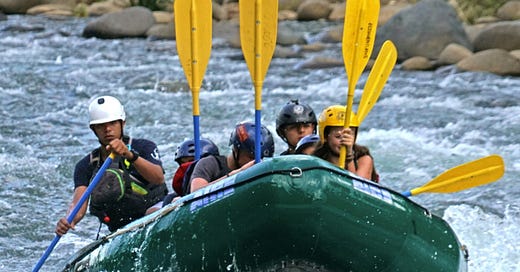“The care of rivers is not a question of rivers, but of the human heart.” ~ Tanako Shozo
True leadership emerges not through control, but through connection—flowing with change rather than fighting against it. Imagine standing at the edge of a roaring river, preparing for a whitewater adventure. Your heart races—a natural response to the unknown—but the presence of your guide helps your nervous system find a state of alert readiness. As you watch her study the water’s patterns, point out subtle changes in the current, and personally connect with each member of your group, you witness a masterclass in leadership.
Two guides might approach the same rapid differently. One barks commands: “Paddle harder! No, not like that—exactly when I say!” The crew, tense and uncertain, responds mechanically. Another guide builds trust early, helping her crew understand the river’s language. “See how the water pillows over that rock? When we approach it, we’ll lean into that V-shaped current—it’s going to carry us naturally around the bend.’ Her crew, understanding the “why” behind each instruction, moves with fluid confidence.
The wisest guides never fall into the trap of believing they can control the river. Instead, they develop a resonant relationship with their crew and the river’s rhythms. Their leadership emerges not from imposing their will, but from hours of listening and observing. Watch a skilled guide reading a rapid: she’ll study the water’s texture, noting how sunlight reveals subtle patterns beneath the surface. When conditions suddenly change—a fallen tree appears around a bend—she doesn’t freeze or panic. Instead, she draws on this deep attunement to find a new path forward, letting go of her original plan rather than being pulled under by rigid expectations.
In truth, who is really navigating the raft? No one person. The people in the raft form a dynamic system that navigates together, with the guide serving as a curator of collective intelligence and energy rather than a commander. This relationship with the river mirrors the way leaders engage with culture. Culture is alive, like the river. It can’t be taught; it has to be caught. Leaders who embrace this distinction understand that culture is not a fixed set of rules but a living, shifting current.
Heraclitus captured this essence perfectly: “No man ever steps in the same river twice, for it’s not the same river and he’s not the same man.” Both the river and the individuals within the system are in constant motion, shaped by each other and by time. In organizational life, culture is shaped not by declarations or handbooks but by the ongoing flow of relationships and actions. Leaders who attune themselves to these patterns—just as a guide listens to the river—influence culture not by force but by fostering learning, connection and care.
This adaptive capacity becomes crucial as change accelerates. Just as every spring brings new river conditions—fallen trees, shifted rocks, altered channels—today’s social landscape constantly evolves. The illusion of control through rigid systems shatters against this reality. Yet many leaders grip tighter, creating the very turbulence they fear. Consider how Reed Hastings navigated Netflix through industry disruption by releasing control of their DVD business to embrace streaming, trusting the current rather than fighting it.
The way forward lies in developing what river guides call “situational awareness”—a capacity to read conditions, respond to subtle signals, and maintain connection even in challenging moments. This isn’t just about being more flexible; it’s about fundamentally shifting how we understand leadership itself. When faced with workplace uncertainty, effective leaders don’t double down on control. Instead, they create space for their teams to sense and respond collectively, much like a well-practiced river crew.
Leadership, like river guiding, is fundamentally an act of care. Technical skills matter, but the heart of the practice lies in relationship—with your team, with changing conditions, with the larger purpose you serve. The most effective leaders release the illusion of control and access a deeper kind of power—one that flows not from domination but from understanding the living systems they serve.
To navigate today’s rapids, start by listening more than directing. Build trust before crisis hits. Practice letting go of perfect plans while holding firm to core values. As Tanako Shozo reminds us, caring for our organizations isn’t ultimately about processes or profits, but about the human heart—one that knows when to hold on and when to let go, flowing with the current rather than being pulled under.
Stay passionate!






I love how you capture the spirit of what leadership is all about here. As Bobby D. says, "You gotta serve somebody."
I love this one,Tom. Leadership as one other wise person recently stated is more about "allowing" calling out that which is alive in every single human, when needed just in time.